Abstract
Objective:
To investigate the change in the physical properties of conventional and Super Slick elastomeric ligatures after they have been in the mouth.
Materials and Methods:
Nine healthy volunteers took part. One orthodontic bracket was bonded to a premolar tooth in each of the four quadrants of the mouth. Two conventional and two Super Slick elastomeric ligatures were placed at random locations on either side of the mouth. The ligatures were collected after various time intervals and tested using an Instron Universal testing machine. The two outcome measures were failure load and the static frictional resistance.
Results:
The failure load for conventional ligatures was reduced to 67% of the original value after 6 weeks in situ. Super Slick elastomeric ligatures showed a comparable reduction after 6 weeks in situ (63% of original value). There were no statistical differences in the static friction between conventional and Super Slick elastomerics that had been in situ for either 24 hours (P = .686) or 6 weeks (P = .416). There was a good correlation between failure load and static friction (r = .49).
Conclusions:
There were statistically significant differences in the failure loads of elastomerics that had not be placed in the mouth and those that had been in the mouth for 6 weeks. There were no differences in the static frictional forces produced by conventional and Super Slick ligatures either before or after they had been placed in the mouth. There appears to be a direct proportional relationship between failure load and static friction of elastomeric ligatures.
Keywords: Elastomeric ligatures, Physical properties
INTRODUCTION
A common method of ligating archwires to brackets is to use elastomeric ligatures. Elastomers are high molecular weight amorphous polymers that exhibit physical properties such as viscoelasticity, creep, and stress relaxation. They are relatively quick and easy to use, but they do produce high levels of frictional resistance and deteriorate in the mouth leading to subsequent loss of tooth control.1–3
A different type of elastomeric ligature was introduced in 2000 (Super Slick, TP Orthodontics Inc, La Porte, Ind) with a covalently bonded Metafix coating, which the manufacturers claim decreases friction. Studies have found contradictory results, with some authors concluding that coated ligatures reduced friction4 and others finding no difference or increased friction.3,5 Much of the previous work on the physical properties of elastomeric ligatures has been carried out in vitro. The in vivo environment differs markedly from in vitro conditions because of variables such as diet, masticatory forces, and temperature.6
The aim of this study was to investigate the change in two physical properties of conventional and Super Slick orthodontic ligatures after they have been in the mouth for varying lengths of time. These were:
The failure load when the ligatures were stretched. This might give an indication into the likelihood that the elastomeric will fail during use with loss of control of the tooth.7
The static friction force required to move a 0.019- × 0.025-inch stainless steel archwire through a bracket with the sample ligature in situ. This indicates the level of force needing to be overcome each time the tooth moves.8
In addition, the relationship between the failure load and static friction was examined.
MATERIALS AND METHODS
Ethical approval was granted by the South Sheffield Local Research Ethics Committee (Reference: 05/Q2305/1). Healthy adult volunteers were invited to participate in the study. A sample size calculation based on previous work2 suggested a sample of five individuals should be sufficient to find a reduction in tensile strength of one-sixth of the original force, with a significance level of .05 and a power of .9.
The inclusion criteria were that participants had at least one premolar in each quadrant of the mouth and were not currently undergoing orthodontic treatment. Volunteers with poor oral hygiene and medical contraindications such as allergy to nickel were excluded.
Clinical Method
Stainless steel premolar orthodontic brackets (0.022-inch slot Ovation Roth, Dentsply, GAC International, Bohemia, NY) were bonded to one premolar in each quadrant of five participants. For the failure load test, the elastomeric ligatures compared were grey conventional (TP orthodontics) and grey Super Slick (TP Orthodontics). For the static friction test, the elastomeric ligatures compared were grey conventional (American Orthodontics, Sheboygan, Wis) and grey Super Slick (TP Orthodontics). The Super Slick elastomeric ligatures were placed on the upper and lower brackets, either on the right side or on the left side by the investigator using mosquito forceps. The regular elastomeric ligatures were placed on the contralateral brackets. The experimental (Super Slick) sides of each participant were randomly allocated by the toss of a coin.
The ligatures were collected after 24 hours, rinsed under cold water to remove proteinaceous material and immediately transported in a polyethylene container to the laboratory to be tested. The experimental method was repeated after elastomeric ligatures had been in the mouth of each participant for 24 hours, 48 hours, 1 week, 2 weeks, 4 weeks, and 6 weeks. At each time period a new experimental side was randomly determined by the toss of a coin. Ten conventional and ten experimental ligatures that had not been used intraorally were rinsed with cold water and tested immediately to obtain a baseline result for each outcome measure. For consistency of testing, all measurements were collected by one individual.
Laboratory Method
All tests were carried out with an Instron Lloyd LRX machine (Lloyd Instruments, TIC, Fareham, UK) and Nexygen software.
Failure Load
The first outcome measure was the maximum amount of force on stretching prior to breaking the ligatures. A customized jig was fabricated from two hooks of 0.9-mm stainless steel wire (Figure 1). These were used to engage each module as passively as possible with the moving element of the Instron machine under manual control. A 100-N load cell was then set with a crosshead speed of 5 mm per minute using the “stretch to break” setting.
Figure 1.
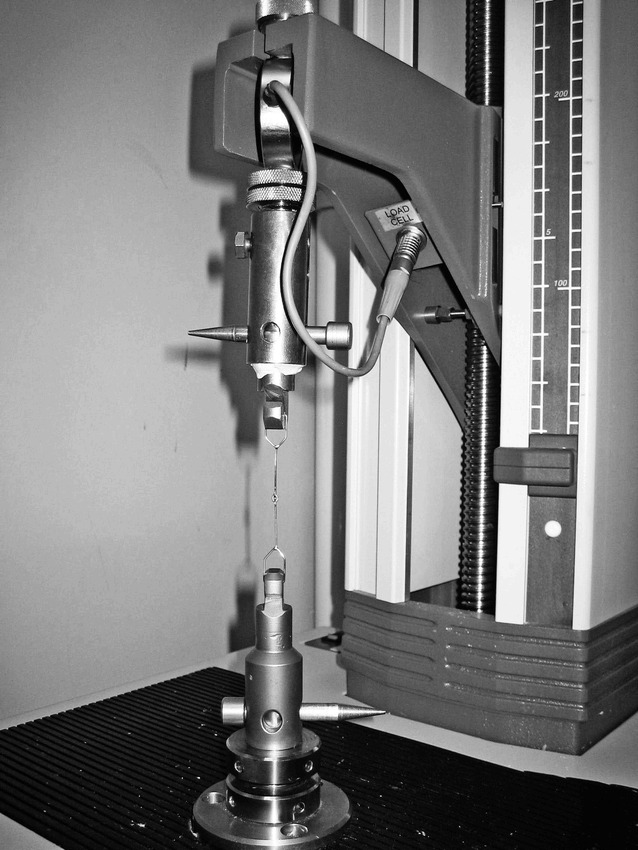
Customized jig used to test failure load.
Static Friction
For the second outcome measure, the ligatures were placed, using mosquito forceps, onto a new bracket and archwire, which had previously been cleaned with an alcohol wipe. The Instron machine was set to a crosshead speed of 20 mm per minute. The frictional force was tested over an 8-mm distance using straight 70-mm lengths of 0.019- × 0.025-inch stainless steel archwires (Dentsply GAC). The wire was securely attached into a heavy base metal block. A 1-cm right angle bend in the wire ensured no vertical movement during testing. Every effort was made to ensure that the sample was parallel with the vertical framework of the machine. The bracket was pulled in a vertical direction by a loop of 0.5-mm stainless steel wire, and the force required to initiate movement was measured. The software was set to highlight the maximum frictional force at initial movement, which was taken to represent the peak static frictional resistance.
Statistical Analysis
Four ligatures were collected and tested at each time point from each participant. The outcome measurements of the two conventional ligatures collected from one side of the mouth (one upper and one lower) of an individual participant were averaged, as were the outcome measurements of the two Super Slick ligatures from the contralateral side of the mouth.
The data were examined using the methods advocated by Matthews et al9 for the analysis of serial data. Separate graphs for failure load and static friction against time were produced using the means values of individual participants. The summary statistics used to describe each outcome were the measurements before the elastomerics were used, after 24 hours and at 6 weeks in vivo. Due to the small number of participants and the difficulty of determining the distribution of the data, boxplots were produced to describe the data and the null hypothesis was tested with nonparametric methods. The Mann-Whitney U-test was performed to examine differences between the elastomerics that were not placed in the mouth and those that had been in situ for 6 weeks. The Wilcoxon matched pairs signed rank sum test was performed to test the differences between the elastomeric ligatures that had been in the mouth for 24 hours and those that had been in the mouth for 6 weeks and between the conventional and Super Slick elastomerics at the two time periods. Both sets of data were considered to be paired because they were collected from the same participant.
The association between the failure load and the static friction was examined by calculating the mean values from the five participants at each time point for both the conventional and Super Slick and producing a scatterplot of the two variables. It was determined from the scatterplots that the data were approximately normally distributed; therefore, the association was tested using Pearson's product moment correlation coefficient.
RESULTS
Nine healthy adult volunteers between the ages of 22 and 49 were recruited to take part in the study. Four individuals took part in the study investigating failure load, and four took part in the static friction study and one took part in both.
The total number of elastomeric ligatures collected during the experiment was 240; 120 for each outcome (four ligatures from five participants over six time points for each outcome). No participants withdrew from the study. Three modules failed during the clinical test period for the failure load test (one conventional and two Super Slick). They were replaced and the intraoral period repeated.
Figure 2a shows the five individual plots of the failure load measurements over time from the conventional elastomeric ligatures. The elastomerics that had been in the mouth for 24 hours showed reasonably consistent failure load values, but the spread increased up to a maximum at 6 weeks, mainly due to the data from two participants. There was a statistically significant difference in the failure loads for the elastomerics that had not been placed in the mouth and those that had been in the mouth for 6 weeks for both the conventional (Mann-Whitney U-test, P = .009) and Super Slick elastomerics (Mann-Whitney U-test, P = .009). The difference between the values for failure load from the elastomerics that had been in the mouth for 24 hours and the elastomerics that had been in the mouth for 6 weeks was not statistically significant for either the conventional (Wilcoxon test, P = .686) or Super Slick elastomerics (Wilcoxon test, P = .225). The difference between the failure load values for the 24-hour conventional and Super Slick elastomerics was statistically significant only at the .05 level (Wilcoxon test, P = .043) and not significant for the 6-week ligatures (Wilcoxon test, P = .345).
Figure 2.
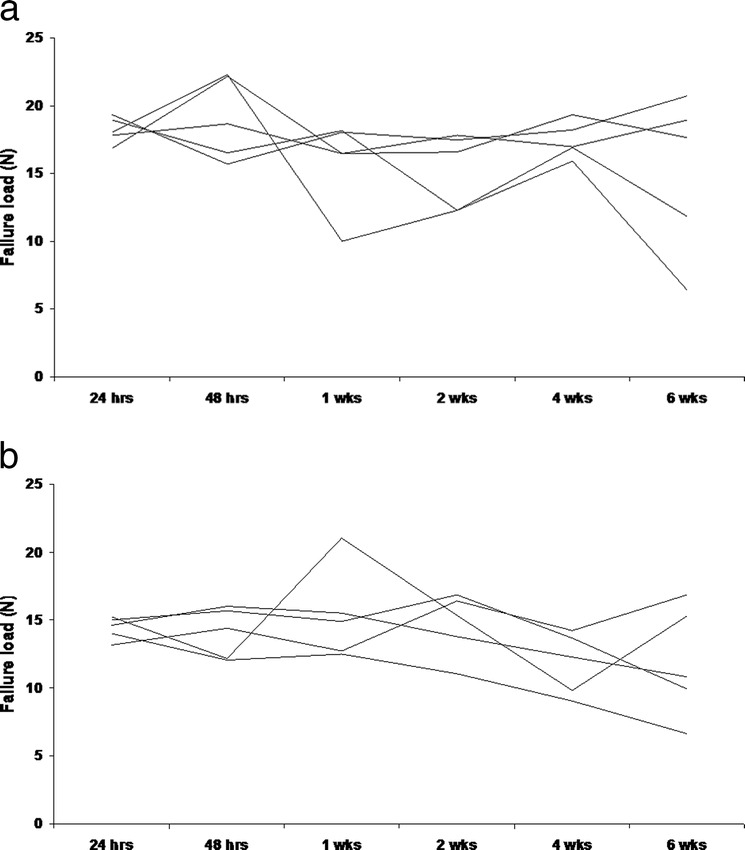
Plots of the five participants' failure load measurements from elastomeric ligatures (mean of two ligatures) placed in the mouth for six different periods. (a) Conventional elastomeric ligatures. (b) Super Slick elastomeric ligatures.
Figure 2b shows the five individual plots of the failure load values over time from the Super Slick elastomeric ligatures. This figure also demonstrates that the elastomerics that had been in the mouth for 24 hours had reasonably consistent failure load values, but that the spread increased up until 6 weeks. This variation was much less than with the conventional elastomerics. There was no significant difference between the failure load at 24 hours and at 6 weeks (Wilcoxon test, P = .345).
Figure 3 shows the individual data for the static friction values at the different time points. These results were much more variable than the failure load for both conventional (Figure 3a) and Super Slick elastomerics (Figure 3b). There also appeared to be the opposite trend to that of the failure load because the individual data were less variable after the elastomeric had been in the mouth for 6 weeks compared with 24 hours. There was a significant difference in the static friction for the elastomerics that had not been placed in the mouth and those that had been in the mouth for 6 weeks for both the conventional (Mann-Whitney U-test, P = .028) and Super Slick elastomerics (Mann-Whitney U-test, P = .016).There were no statistically significant differences between the static friction values from the 24-hour and 6-week ligatures for either the conventional (P = .225) or the Super Slick elastomerics (P = .686). Nor was there a statistical difference between conventional and Super Slick elastomerics at either 24 hours (P = .686) or 6 weeks (P = .416).
Figure 3.
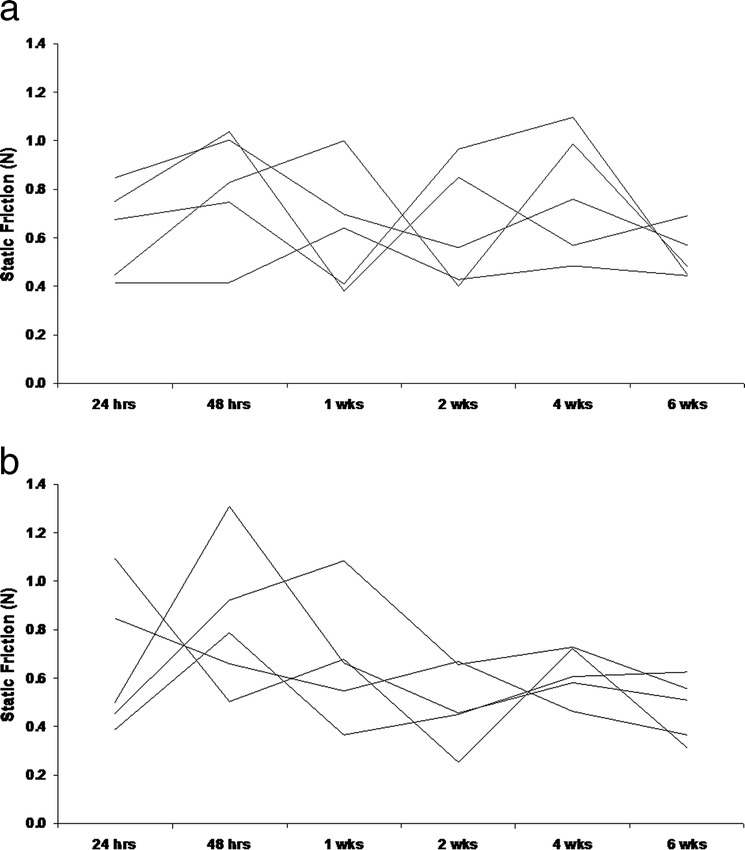
Plots of the five participants' static friction measurements from elastomeric ligatures (mean of two ligatures) placed in the mouth for six different periods. (a) Conventional elastomeric ligatures. (b) Super Slick elastomeric ligatures.
The boxplots of the failure load data (Figure 4) demonstrate a pronounced decrease in the failure load even after the elastomerics had been in the mouth for 24 hours, although the variation is quite small. The variation in the failure load increased markedly after the elastomerics had been in the mouth for 6 weeks. The boxplots of the static friction data (Figure 5) demonstrate great variability even before the elastomerics had been placed in the mouth.
Figure 4.

Boxplot showing the median, interquartile range and minimum and maximum values for the failure load (N) for the conventional and Super Slick elastomeric ligatures before being placed in the mouth, after being in the mouth for 24 hours and 6 weeks (N = 5).
Figure 5.
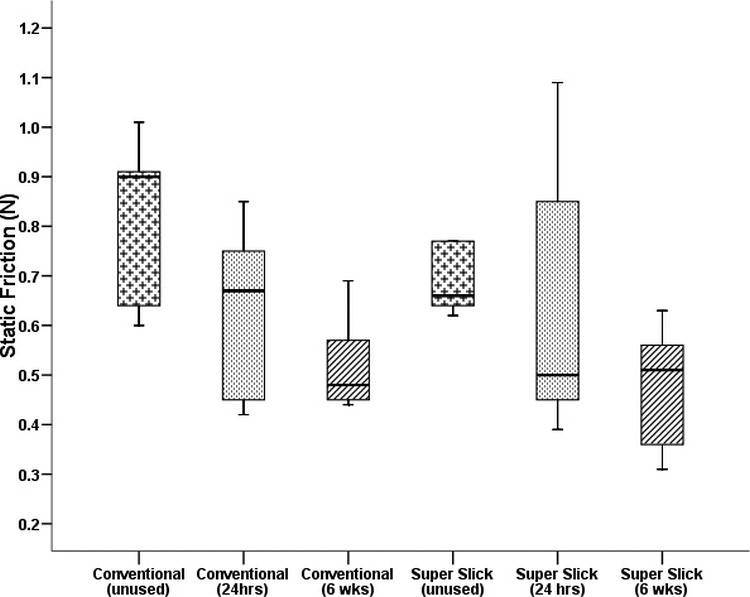
Boxplot showing the median, interquartiles, and range for the static friction (N) for the conventional and Super Slick elastomeric ligatures before being placed in the mouth, after being in the mouth for 24 hours and 6 weeks (N = 5).
A scatterplot of the mean values (Figure 6) shows an approximately direct linear relationship between static friction and failure load (r = 0.49) suggesting that as the failure load increases, so does the static friction.
Figure 6.
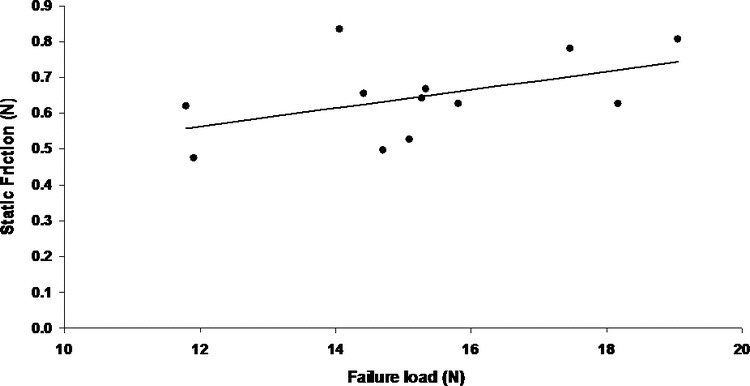
Scatterplot showing the association between mean failure load and mean static friction measurements collected at six different periods (N = 12; r = .49).
DISCUSSION
This study looked at the effect of intraoral use on two properties of elastomeric ligatures: failure load and static friction. Our results suggest that there is an association between the force required to break an elastomeric ligature and the static friction generated when the elastomeric is used to ligate an archwire to a bracket. Both generally decreased with increasing amount of time in the mouth; however, the results, particularly for static friction, were very variable.
Failure Load
There is general agreement in the literature that elastomeric materials deteriorate with time, and this will make them less effective in their role of ligating archwires. The rate at which they deteriorate will depend upon the conditions they are subjected to, and the intraoral environment is difficult to reproduce in the laboratory.6 Although several studies have examined the force decay of elastomeric chain10,11 or latex intermaxillary elastics12 after they have been in the mouth, few studies have examined the force characteristics of elastomeric ligatures after they have been in situ.
Interestingly, the results of our in situ study concur with those of the best outcomes from the laboratory studies, although the variability was greater and increased the longer the material was in the mouth. Taloumis et al1 found that the mean forces required to stretch the elastomeric ligature to 5.5 mm after 28 days were between 52% and 75% of the original value when the elastomeric was stored in air and between 34% and 58% when stored in an artificial saliva bath. Dowling et al7 found that mean failure loads after 4 weeks in a water bath were between 65% and 91% of the starting value, and Lam et al2 demonstrated that the mean load failures were between 73% and 91% of the original value after 12 weeks in artificial saliva. The failure load for conventional ligatures in our study was 80% of the original force after they had been in the mouth for 24 hours, which reduced further to 67% of the original value after 6 weeks in situ. Comparable values were obtained for the Super Slick elastomeric ligatures (76% of original value at 24 hours in situ, reducing to 63% after 6 weeks).
Friction
The second outcome investigated was the coefficient of static friction. Although both kinetic and static frictions have been assessed in the literature, the static friction is more commonly quoted. Some consider static friction to be the more important value because of the binding and uprighting nature of tooth movement.8,12 Others have argued that the static friction is affected by lubrication, therefore kinetic friction offers a more reliable measurement.13 Our data did suggest there was great variability in the static friction measurements.
For this investigation we chose to reproduce as closely as possible the methodology of two previous studies looking at conventional and Super Slick elastomeric ligatures in vitro.4,14 Our results accept the null hypothesis that there is no difference in the frictional resistance of conventional and Super Slick orthodontic elastomeric ligatures, although wide variations were seen. Similar large variations have been found with different methods for testing friction.3,5 Our results contradict the findings of Hain et al14; however, it is possible that differences in lubrication account for this discrepancy. The literature has shown many conflicting results regarding the effect of lubrication on friction in laboratory studies.15 We believed that it would be difficult to ensure that the ligatures were covered in exactly the same amount of saliva if droplets were being used, and for this reason it was felt that testing in a dry environment would give more standardized results.
Relationship Between the Ligature Force and Friction
There are few studies in the literature comparing the changes in the force levels produced by an elastomeric ligature and the frictional resistance created.7,13 Dowling et al7 found a 9% decrease in tensile strength and a 9% increase in static friction after conventional grey ligatures were stored in a water bath for 4 weeks. Bortoly et al13 found a high correlation between the tensile and the frictional forces after storage under various conditions for 21 days.
Again, the data from our in situ investigation suggest that the results from in vitro studies, particularly those carried under wet conditions, might be a reasonable estimation of the change in the elastomeric properties over time in the mouth. The static friction when ligating archwires with conventional elastomerics that had been in the mouth for 24 hours was 77% of the original level and this reduced to 65% of the original value after ligating with conventional elastomerics that had been in situ for 6 weeks. The comparable figures for the Super Slick elastomeric ligatures were 88% of the original force when ligating with elastomers that had been in the mouth for 24 hours and 64% of the original force when ligating with elastomers that had been in situ for 6 weeks. Our data also suggest that there is a relationship between the force properties of the elastomeric ligature and the frictional resistance, although the static friction readings were highly variable.
One criticism of the study might be the size of our sample. Our sample size was based on a calculation using parametric data from the work of Lam et al2 with a proposed reduction in the tensile strength of one-sixth of the original force, or in other words, a reduction to 83% of the original value. This reduction in failure load was achieved within 24 hours of the elastomers being in situ. There was a substantial increase in variability of measurements after the materials had been in the mouth, and this should be taken into account in future studies.
CONCLUSIONS
There were statistically significant differences in the failure loads of elastomerics that had not been placed in the mouth and those that had been in the mouth for 6 weeks.
There were no differences in the static frictional forces produced by conventional and Super Slick ligatures before or after they had been placed in the mouth; however, the data were highly variable.
There appears to be a direct proportional relationship between the failure load and the static frictional resistance.
REFERENCES
- 1.Taloumis L. J, Smith T. M, Hondrum S. O, Lorton L. Force decay and deformation of orthodontic elastomeric ligatures. Am J Orthod Dentofacial Orthop. 1997;111:1–11. doi: 10.1016/s0889-5406(97)70295-6. [DOI] [PubMed] [Google Scholar]
- 2.Lam T. V, Freer T. J, Brockhurst P. J, Podlich H. M. Strength decay of orthodontic elastomeric ligatures. J Orthod. 2002;29:37–43. doi: 10.1093/ortho/29.1.37. [DOI] [PubMed] [Google Scholar]
- 3.Khambay B, Millett D, McHugh S. Evaluation of methods of archwire ligation on frictional resistance. Eur J Orthod. 2004;26:327–332. doi: 10.1093/ejo/26.3.327. [DOI] [PubMed] [Google Scholar]
- 4.Hain M, Dhopatkar A, Rock P. A comparison of different ligation methods on friction. Am J Orthod Dentofacial Orthop. 2006;130:666–670. doi: 10.1016/j.ajodo.2006.04.021. [DOI] [PubMed] [Google Scholar]
- 5.Griffiths H. S, Sherriff M, Ireland A. J. Resistance to sliding with 3 types of elastomeric modules. Am J Orthod Dentofacial Orthop. 2005;127:670–675;quiz 754. doi: 10.1016/j.ajodo.2004.01.025. [DOI] [PubMed] [Google Scholar]
- 6.Eliades T, Bourauel C. Intraoral aging of orthodontic materials: the picture we miss and its clinical relevance. Am J Orthod Dentofacial Orthop. 2005;127:403–412. doi: 10.1016/j.ajodo.2004.09.015. [DOI] [PubMed] [Google Scholar]
- 7.Dowling P. A, Jones W. B, Lagerstrom L, Sandham J. A. An investigation into the behavioural characteristics of orthodontic elastomeric modules. Br J Orthod. 1998;25:197–202. doi: 10.1093/ortho/25.3.197. [DOI] [PubMed] [Google Scholar]
- 8.Read-Ward G. E, Jones S. P, Davies E. H. A comparison of self-ligating and conventional orthodontic bracket systems. Br J Orthod. 1997;24:309–317. doi: 10.1093/ortho/24.4.309. [DOI] [PubMed] [Google Scholar]
- 9.Matthews J. N, Altman D. G, Campbell M. J, Royston P. Analysis of serial measurements in medical research. Br Med J. 1990;300:230–235. doi: 10.1136/bmj.300.6719.230. [DOI] [PMC free article] [PubMed] [Google Scholar]
- 10.Eliades T, Eliades G, Silikas N, Watts D. C. Tensile properties of orthodontic elastomeric chains. Eur J Orthod. 2004;26:157–162. doi: 10.1093/ejo/26.2.157. [DOI] [PubMed] [Google Scholar]
- 11.Bousquet J. A, Jr, Tuesta O, Flores-Mir C. In vivo comparison of force decay between injection molded and die-cut stamped elastomers. Am J Orthod Dentofacial Orthop. 2006;129:384–389. doi: 10.1016/j.ajodo.2005.09.002. [DOI] [PubMed] [Google Scholar]
- 12.Wang T, Zhou G, Tan X, Dong Y. Evaluation of force degradation characteristics of orthodontic latex elastics in vitro and in vivo. Angle Orthod. 2007;77:688–693. doi: 10.2319/022306-76. [DOI] [PubMed] [Google Scholar]
- 13.Bortoly T. G, Guerrero A. P, Rached R. N, Tanaka O, Guariza-Filho O, Rosa E. A. Sliding resistance with esthetic ligatures: an in-vitro study. Am J Orthod Dentofacial Orthop. 2008;133:340.e1–7. doi: 10.1016/j.ajodo.2007.08.015. [DOI] [PubMed] [Google Scholar]
- 14.Hain M, Dhopatkar A, Rock P. The effect of ligation method on friction in sliding mechanics. Am J Orthod Dentofacial Orthop. 2003;123:416–422. doi: 10.1067/mod.2003.14. [DOI] [PubMed] [Google Scholar]
- 15.Stannard J. G, Gau J. M, Hanna M. A. Comparative friction of orthodontic wires under dry and wet conditions. Am J Orthod. 1986;89:485–491. doi: 10.1016/0002-9416(86)90006-0. [DOI] [PubMed] [Google Scholar]


